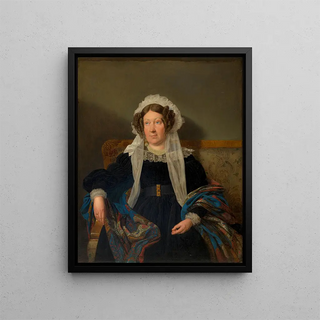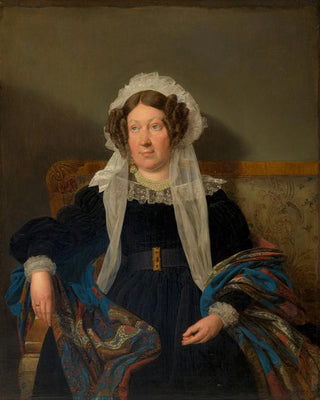Art print | Joséphine Schwartz von Mohrenstern née Vicomtesse Goupy de Quabeck - Ferdinand Georg Waldmüller


View from behind

Frame (optional)
In the fascinating world of art, some works stand out for their ability to capture the essence of a period and evoke deep emotions. The art print of Joséphine Schwartz von Mohrenstern née Vicomtesse Goupy de Quabeck by Ferdinand Georg Waldmüller is one of these iconic pieces. This portrait, which demonstrates technical mastery and remarkable artistic sensitivity, immerses us in the intimate universe of the 19th century. Through the delicate features of Joséphine, Waldmüller invites us to explore not only her external beauty but also the subtleties of her soul and social status. The piece thus becomes a mirror of the society of its time, revealing tensions between tradition and modernity.
Style and uniqueness of the work
Ferdinand Georg Waldmüller’s style is characterized by a realistic approach, where every detail is carefully observed and rendered. In this portrait, light plays a predominant role, illuminating Joséphine’s face with a soft, natural glow, while the background, discreet yet evocative, highlights the central figure without ever diverting our gaze. The colors, chosen with care, create a visual harmony that enhances the impression of serenity and dignity. Waldmüller excels in representing textures, whether it is the sumptuous clothing of his model or the elements of nature surrounding her. This attention to detail, combined with a balanced composition, gives the work emotional depth that transcends the simple portrait to become a true exploration of identity and social standing.
The artist and his influence
Ferdinand Georg Waldmüller is an essential figure in 19th-century Austrian art. His artistic journey, marked by an incessant quest for truth and beauty, has captivated a wide audience. Influenced by Romanticism, Waldmüller also aligned himself with realistic ideals, seeking to depict everyday life with unique sensitivity. His work is set against a backdrop of social and cultural upheavals, where art becomes a means of expression of the

Matte finish

View from behind

Frame (optional)
In the fascinating world of art, some works stand out for their ability to capture the essence of a period and evoke deep emotions. The art print of Joséphine Schwartz von Mohrenstern née Vicomtesse Goupy de Quabeck by Ferdinand Georg Waldmüller is one of these iconic pieces. This portrait, which demonstrates technical mastery and remarkable artistic sensitivity, immerses us in the intimate universe of the 19th century. Through the delicate features of Joséphine, Waldmüller invites us to explore not only her external beauty but also the subtleties of her soul and social status. The piece thus becomes a mirror of the society of its time, revealing tensions between tradition and modernity.
Style and uniqueness of the work
Ferdinand Georg Waldmüller’s style is characterized by a realistic approach, where every detail is carefully observed and rendered. In this portrait, light plays a predominant role, illuminating Joséphine’s face with a soft, natural glow, while the background, discreet yet evocative, highlights the central figure without ever diverting our gaze. The colors, chosen with care, create a visual harmony that enhances the impression of serenity and dignity. Waldmüller excels in representing textures, whether it is the sumptuous clothing of his model or the elements of nature surrounding her. This attention to detail, combined with a balanced composition, gives the work emotional depth that transcends the simple portrait to become a true exploration of identity and social standing.
The artist and his influence
Ferdinand Georg Waldmüller is an essential figure in 19th-century Austrian art. His artistic journey, marked by an incessant quest for truth and beauty, has captivated a wide audience. Influenced by Romanticism, Waldmüller also aligned himself with realistic ideals, seeking to depict everyday life with unique sensitivity. His work is set against a backdrop of social and cultural upheavals, where art becomes a means of expression of the






